Welcome to Part 1 of “My Eczema Baby” series. You may have landed here because your baby is battling eczema, too. When you have a baby with eczema, you often think, “how do I make it go away?” But that leads to the question: Which do you tackle first: managing the symptoms or trying to determine the root cause? It can be a chicken or egg scenario.
Managing baby eczema symptoms offers temporary relief, but we noticed a significant difference only once we searched for the root cause(s). In this post, I’ll cover part of our 6+ month journey to battle our baby’s eczema and offer symptom management suggestions that worked for us so you can try them, too. In the next post, Part 2 of My Eczema Baby series, I’ll write about how we searched for the causes.
Please consult your child’s pediatrician or allergist for the best path forward for your baby. This is not meant to be medical advice and all suggestions may not be applicable for all babies.
Also, this post contains affiliate links for which I may receive a small commission at no added cost to you as an Amazon Associate. I recommend products only that we’ve tried and loved.
There’s no easy way to say it: Battling baby eczema sucks
What’s the hardest part about being a mom? I thought it would be sleep deprivation. But nothing could have prepared me for our battle with eczema.

Trying to get a grasp on a baby’s eczema, a form of atopic dermatitis (AD), is such a frustrating battle to undertake. Research has concluded that eczema (at least for babies) is often genetic, or a symptom of underlying causes such as environmental factors or dietary allergies. The challenge is, a quick search in my eczema support groups revealed medical professionals vary in their opinions about the severity of eczema, what to do about it—or even whether it’s treatable.
And it doesn’t help when uneducated people do a double-take, or steer clear thinking your little one is contagious. “What’s wrong with her face?” people ask. How do I respond to that? This tiny, wrinkly ball of a human is already being judged on her appearance. Nothing is wrong with her face. She’s battling eczema and is having a flare-up.
Identifying the cause feels insurmountable when you’re faced with weeping, scaly rashes, and an infant that’s so uncomfortable that she’s scratching herself until she’s bloody. Uneducated guidance or lack of support can make a mama feel completely helpless. We were extremely fortunate to have a supportive care team on our side who guided our journey, but not every family is so lucky to have such support. That made me angry! And that’s how this post was born.
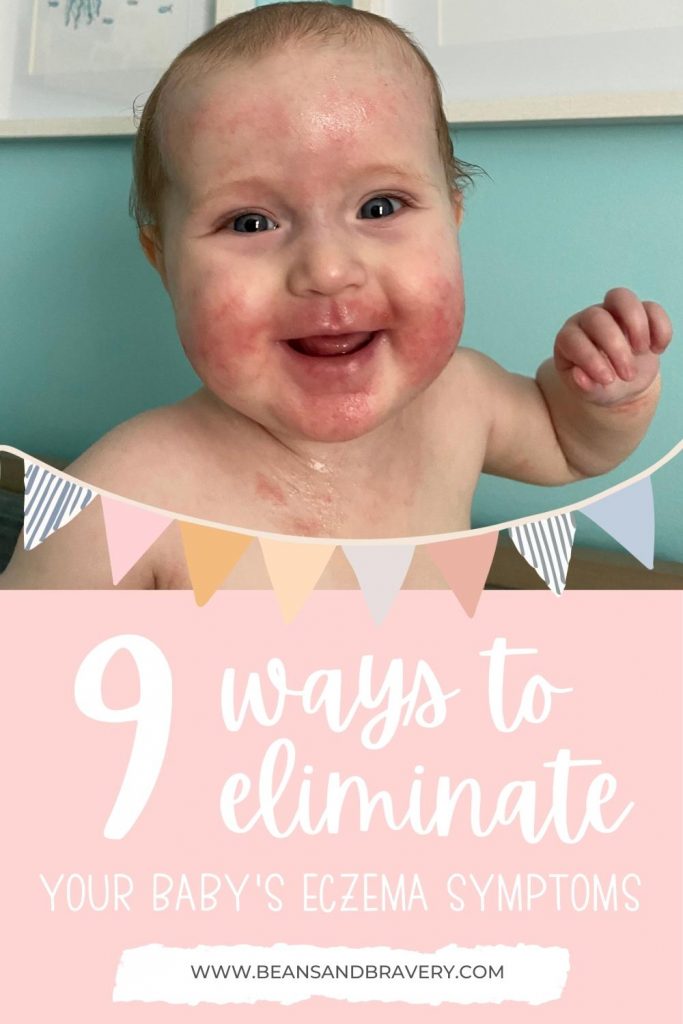
Is baby eczema common?
Baby eczema is more common than you may think.
According to the National Eczema Association, roughly 9.6 million U.S. children under the age of 18 have eczema. One-third have a moderate to severe form.
The numbers may say baby eczema is common, but the condition can feel so isolating. Parents and caregivers surveyed by the NEA reported they often feel embarrassed about their child’s appearance, and experience feelings of frustration, helplessness, sadness, and guilt. Mama, I’m with you because I’ve experienced all the feels.
What does baby eczema look like?
I was perhaps the opposite of a concerned first-time mama who calls the pediatrician for everything when it first came to our little nugget’s skin. At first, I thought her eczema, which was limited to her face, was baby acne and that it would clear up soon. After all, I had read baby acne was normal and nothing to be concerned about. But it progressively got worse as the days went on.
I didn’t realize how bad it actually was until my mama came for a visit and gently mentioned this wasn’t typical baby acne. Enter mom guilt. I’ll always wonder if I could have done something to prevent it from getting worse. That day, I made our first purchase of products touted for eczema relief.
A few days later, I noticed the redness and patchy skin was spreading. Our little one had barely noticeable blood streaks in her poopy diaper. I immediately called the pediatrician. She suggested bringing the diaper in for a fecal occult test. It came back positive, which indicated bleeding in her digestive tract, which meant she was allergic to something I was eating. Because dairy is the most common allergy, at the recommendation of our pediatrician, we began a dairy elimination journey.
Related Post: Suspect your eczema baby has a milk allergy? You’ll want to read this post.

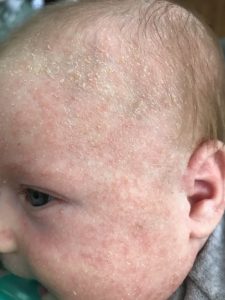


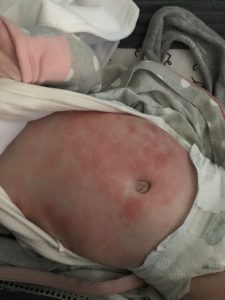
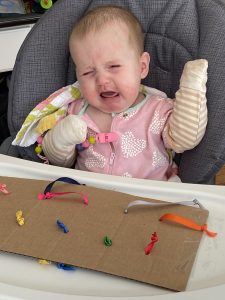
Baby eczema affects more than just skin and diet
Eczema that lasts into childhood can have a significant impact on parents’ emotional and social well-being, too. How could it not when it adds a layer of difficulty to parenthood?
It’s maddening when clear skin one minute becomes red, itchy, and angry only a few minutes later. My brain immediately goes to what did I eat? And what can I do to make it better?
I would bathe her to distract from the scratching. But her eczema flares up worse afterward. (This is common.) I’d be in tears on the bathroom floor, rocking her, trying to soothe her, and trying to keep her little hands contained so she couldn’t scratch herself bloody. There was nothing I could ever do to make it better. I just had to hold her.
Seconds of uninterrupted scratching would erase a week’s worth of effort to calm her skin. No mittens would stay on. So I put socks on her hands. But socks would leave skid marks on her face because she scratched so hard. Any time she got fussy, I had to stop everything and soothe her. Scratching was her instant source of comfort.
Her sheets were permanently bloodstained. Her face would weep a clear fluid, on the brink of infection. She was missing patches of hair. And her skin would shed everywhere. I rotated between a handful of ever-dirty shirts because I was sick of getting Vaseline and bloodstains where she would scratch her head and face against me.
I held off posting photos, waiting for the rare occasion when her skin was less angry so I didn’t get questions or comments. When she was at her worst, we simply didn’t have any answers and that made me feel awful. So I tried to avoid situations where someone would ask.
Sleep deprivation from eczema is real
The worst nights meant waking up to console her every 45-minutes when she would scratch herself awake. But, thankfully most nights we managed to get two hour stretches out of her. Any time someone would ask, “How is she sleeping for you?” I had to tame the pent up frustration I secretly wanted to unload.
No, my baby was not sleeping through the night. Somehow that became an invite to share advice about how some rendition of the Ferber method worked. The truth is, I listen to my baby cry enough. And “self-soothing” guarantees bloodstains that will make you think a baby animal was murdered in her crib.
Eczema isn’t just frustrating because there is no simple answer. It’s brutally isolating, too.
The truth is, mama, we’re not alone. In almost every eczema support group I belong to, sleep help is the most common topic that comes up. Sleep disturbance occurs in approximately 60% of children with AD. And parents of children with AD are four to eight times more likely to average less than six hours of sleep per night compared with caregivers of healthy children. It’s a great night when I get six hours of sleep.
Sleep deprivation took a toll on me and my quest to find a solution nearly made me crazy. We cleared the shelves of creams and ointments, just trying to find a solution.
And just as quickly, many ended up in the trash barely used. I know how maddening it can be to find a regimen that actually works for an eczema baby. My hope is our eczema symptom management regimen will offer you some relief.
How we treated our baby’s eczema and stopped our baby’s itching
So what can you do to help relieve some of your baby’s eczema symptoms and stop your baby’s itching? These 9 steps worked for us:
1. Stop using breastmilk.
Wait! I DO NOT mean stop feeding your infant breastmilk. Rather, stop using breastmilk as a solution for their skin issues. I was all about the liquid gold and using it to cure all of my baby’s ailments … until her pediatrician told me to stop putting breastmilk on her skin because I could be doing more harm than good if she had an allergy. Here I was trying to take the most natural route to cure my baby’s skin issues and it turned out she did have an allergy and I was only making it worse! I felt horrible.
It is perfectly safe to continue breastfeeding your infant, even if they do have allergies. It may take some adaptation to your diet, but you do not need to automatically switch to formula unless otherwise advised by your pediatrician. (And good thing because specially formulated formula can be both expensive and taste awful!) You can read all about eczema-related dairy allergies in my post here.)

2. Ditch clothing that isn’t 100% cotton.
And avoid irritating necklines with fancy stitching. You may be surprised to learn that a lot of baby clothing is made from synthetic chemical blends that can further irritate already damaged skin. When your baby is experiencing an eczema outbreak, make sure everything that touches their skin is as gentle and non-irritating as possible.
For this reason, ditch clothing that has fancy neckline stitching and clothing made with synthetic materials. This includes polyester (and poly blends), rayon, nylon, spandex, and even the snuggly fuzzy fleece. Unfortunately, we found fancy necklines on nearly all of Carter’s girl clothes.
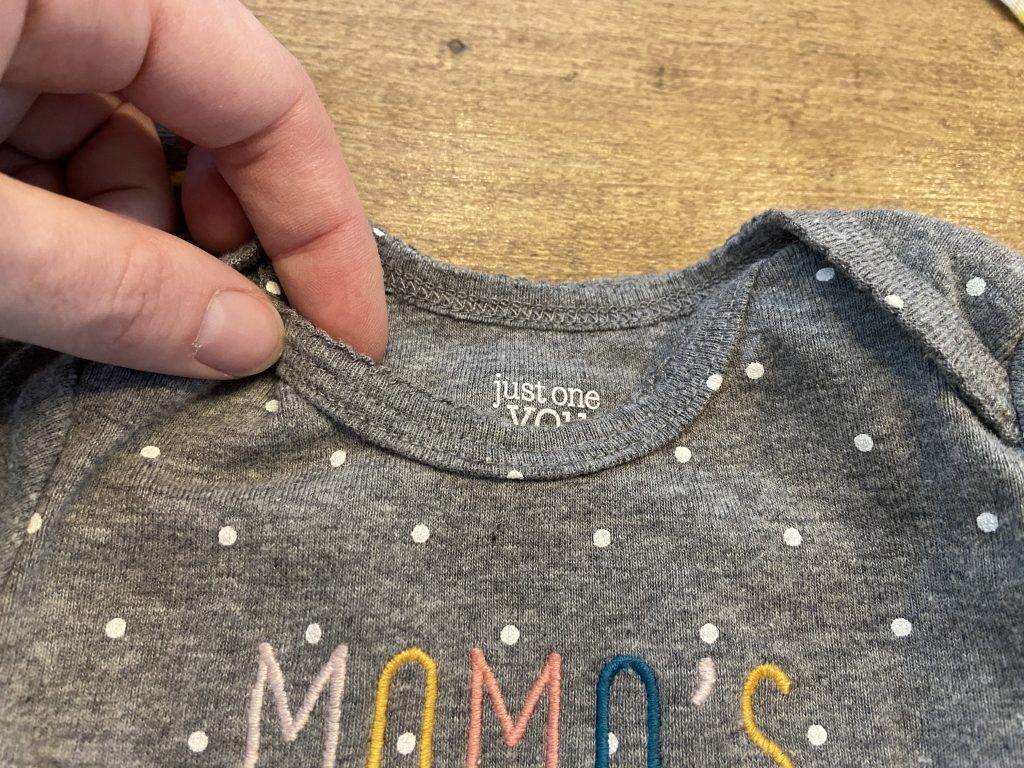
3. Take inventory of your home.
How many fragranced soaps, perfumes, laundry detergents, and dryer sheets do you use? Consider getting rid of them all. This is probably the most difficult change for some families. For so long we’ve been conditioned to believe that fragrance equals clean. Especially when it comes to our laundry, personal care, and cleaning products. After doing extensive research, one thing I learned is that common irritants are found in many products we use daily.
Fragrances are derived from chemicals known to be extremely irritating to our skin such as SLS, formaldehyde (yes, the chemical used to embalm bodies), parabens, for example. But often, these chemicals are masked on ingredient labels under the general “fragrance” term so it’s hard to know which ingredients are in which products.
Related Post: What You Must Know about Dairy Elimination While Breastfeeding
One resource to consult is the National Eczema Association Seal of Acceptance list. If you want to know how your current products rank, the Environmental Working Group offers a database that rates cleaning products and personal care products based on the ingredients disclosed. (EWG offers more information on its methodology here.)
Your house doesn’t have to be completely fragrance-free. One way to maintain a clean scent with your laundry or cleaning regimen is to swap artificially fragrant products for essential oils, which can offer both cleansing properties and naturally occurring fresh scents.
I wish making the switch for baby’s clothes and linens would be enough. But think of how often they are snuggled up in our arms, lying in bed, or curled up in towels. Consider just how many items in your house your baby comes into contact with items that are washed in aggravating detergents.
We couldn’t figure out why Liv would come home from daycare with splotchy patches on her cheeks when she would arrive with a relatively clear face. After talking through potential causes with her teachers, we quickly pinpointed that all of the fabric (lounge chairs, bouncer seats, swings, etc.) in the room was washed using Tide. So were their clothes. When daycare closed and she was home full-time, she had no more daily flares.
4. Buy a good swaddle.
Tame your little one’s hands. It’s the easiest way to keep them from scratching, and to allow their face a few solid hours per day to heal. Take advantage of a swaddle while it is safe. Swaddles such as SwaddleMe or the Ollie Swaddle are great options. If your little one is a Houdini and manages to get their arms free, try the double swaddle method we learned in the hospital from our amazing nurses. Here’s a quick hint:
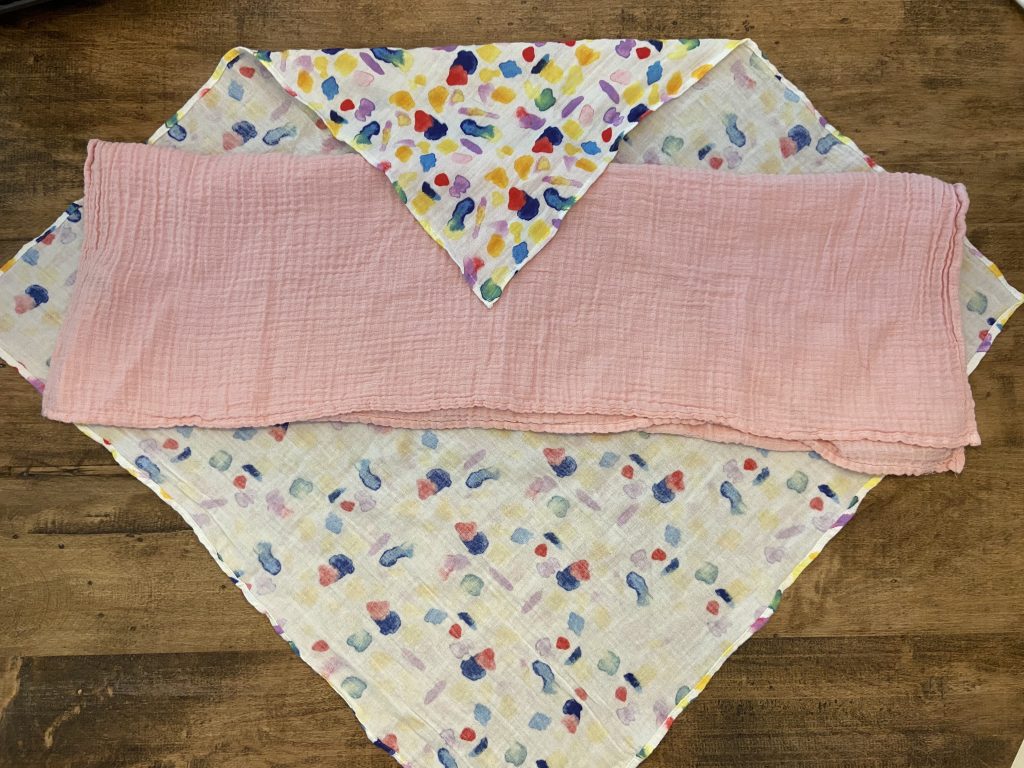
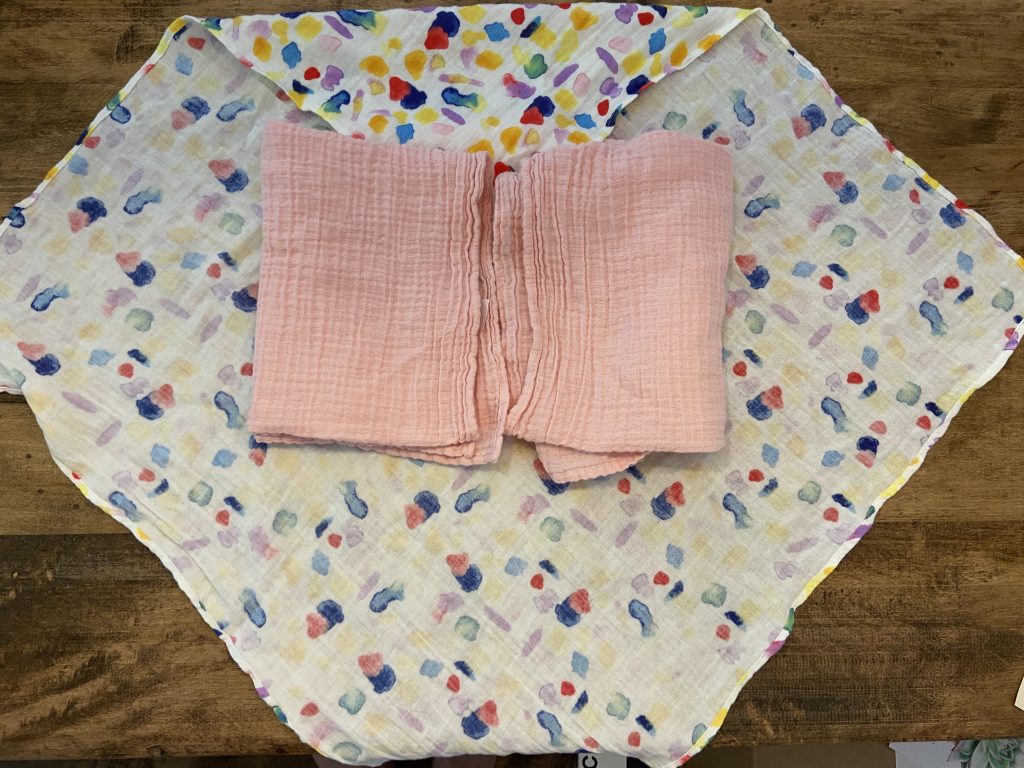
5. Keep nails trimmed and filed.
This one may seem a bit obvious, but I never realized how quickly baby nails grow! Daily trimming helps keep sharp edges to a minimum. This set comes with both nail clippers and a baby-sized nail file. (But I love using this one … and she loves to chew on it.)
6. Scratch sleeves
Even if you keep your baby’s nails trimmed and filed, she’ll find a way to still scratch herself. Once we had to transition out of the swaddle because our baby started rolling over, we didn’t know what we were going to do to keep her from scratching at night.
We tried using socks on her hands, but most socks are made of polyester. Cotton socks were still too rough for the constant scratching. Then I learned about this miracle product.
The Scratch Sleeves were a serious lifesaver for us. Once we started using it, her skin finally started to heal. She can still scratch now that she is in this regular sleep sack, but she does minimal damage because the ends are made of satin and glide across her skin. We put them over her pajamas and under her sleep sack. Her fingers aren’t free to do damage, but there is enough room for her fingers to move so that she can grab her binky and replace it in the middle of the night. This was a HUGE sleep saver for us.
Related Post: What You Must Know about Dairy Elimination While Breastfeeding
7. Satin sheets are an eczema baby’s best friend.
Babies are very resourceful when they need to find a way to tame their itches. I was sick of waking up to bloody sheets and realized that the Scratch Sleeves were only helpful until she started rubbing her face on her sheets. They, too, were 100% cotton, but still too rough. So, I thought silk would be the next best thing. But paying an astronomical amount for silk sheets only for them to get bloody seemed a bit ridiculous; though, for my sanity, I would have spent the money. Before I could click “buy,” Amazon came to my rescue with a recommendation for these satin sheets. It was 1/5th the price of a silk crib sheet … so, I figured they were worth a try. I didn’t have anything to lose. Now, they’re all we use in her crib. No more bloody sheets!
8. Incorporate bleach baths.
What? How in the world could bathing a baby in bleach be a good idea? I’m a clean with Norwex and vinegar type of girl and the thought of buying bleach to use on our baby when I didn’t even use it to clean our house brought a “WTF” to mind. But our pediatric allergist and pediatrician encouraged them to help prevent bacterial infection. Especially when her skin was weepy. I was really willing to try anything.
In reality, the bleach is so diluted in water that it’s as though your baby is swimming in a chlorinated pool. The objective is to prevent skin infections, which require antibiotics. Put into perspective by our allergist, bleach baths are better than constantly resulting to antibiotics (to which they can develop a resistance).
Here are the instructions our pediatrician provided for a bleach bath. Confirm with your pediatrician that this approach is right for your baby before trying. The one downside to bleach baths is they can dry out your baby’s skin. So it’s important to avoid bathing too frequently and have a consistent post-bath routine that will re-hydrate your little one’s skin.
9. Have a post-bath routine.
I’ll always wonder if using “natural” baby products exacerbated our baby’s eczema. I’ll never know, but my hope is that you can learn from what may have been my mistakes. Moisturizing your little one’s skin after bath from birth is critical, especially when he or she develops eczema. It seems counter-intuitive, but baths can suck the moisture out of your little one’s delicate skin.
But what products you moisturize with also matters. When you have a baby with eczema, traditional advice goes out the window. Don’t use lavender scented baby lotion. In fact, avoid any product with a fragrance.
Instead, opt for allergist-recommended, skin-healing, moisturizing products such as CeraVe Moisturizing Cream, Vanicream, or Eucerin Baby Eczema Cream. (Aquaphor is commonly recommended but it did not work for us. Also, if your baby has a soy allergy, avoid this product because the glycerin in Aquaphor is derived from soy.) We found CeraVe to be the most moisturizing of the baby eczema creams we tried.
The type of product you choose matters, too. Ointments are better than creams, but creams are absolutely better than lotions. Lotions have extra alcohol-based thinning ingredients that can dry out your baby’s skin. Opt for ointments or creams which are thicker and, although more annoying to handle, better for eczema babies.
Studies have proven Vaseline is an effective method to help lock in moisture. It’s messy. It’s sticky. You will get Vaseline all over your shirt so wear clothes you don’t care about staining. But it works.
When bath is done, we either lather her up in the bathtub or lightly pat her dry then lather. We apply Vaseline over top of the cream to lock in the moisture.
Trust your gut and keep trying
Finding a baby eczema treatment that works for you and your baby can be a matter of trial and error. Every baby is different and eczema is unique. I hope the suggestions I offered above offer you and your baby some relief.
I’d love to hear in the comments section below (or find me on Instagram) what products you have tried, and what worked for you and your baby. Because eczema care is such a trial and error process, I know other mamas reading this article would value that information, too.
Eczema is a very stressful journey no mama should have to go through alone. If you are interested in joining the Facebook support group I belong to, please let me know and I will add you.
Know another mama who is struggling with baby eczema? Please pin or share this post. Don’t forget to subscribe and let the good stuff come to you!
Good luck, mama!



Oh my God, Kim! I had no idea what you’ve been going through!!! Olivia is beautiful and perfect and you are so strong!! You are doing great, Mama!! Xo (And, I learned so much from this post!! Thank you for sharing your journey!)
❤️❤️❤️
Thank you for sharing this. Nolan had really bad eczema and just recently showed improvement and he’s about 18 months now. Everything you wrote was spot on, from them waking up every 45 minutes crying and scratching to the mom guilt you feel. The sleep deprivation is real! We found eucerin and aquaphor worked best for his skin and I also had stains all over my clothes from all the products lol. Your daughter is adorable and you’re doing a great job 🙂 Can’t wait to read the next article!
Thanks for sharing! I can’t imagine 18 months without relief 😖 Hang in there, mama. We’re all in this together 🙂
My grand daughter also suffers from eczema and scratches herself constantly. After many visits and different steroids at the ped’s she went to a dermatologist and she changed the cremes but also said to take a onesie and get it wet, ring it out and put it on her then put dry clothes over the top before bed…….the kids said this has been the best relief out of everything they have tried. The pediatrician didn’t even know this!! She sleeps in the wet onesie under her pajamas and seems relieved. She is currently 9 months old! Hope this tip helps others!
Hi Julie! Yes, wet-wrapping is definitely a great tip to share, thank you!